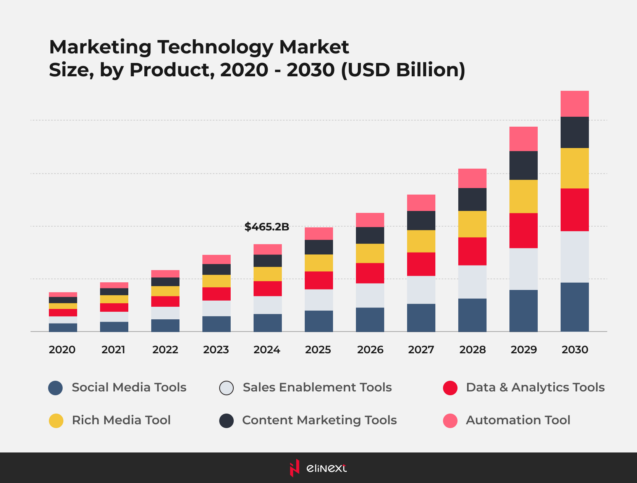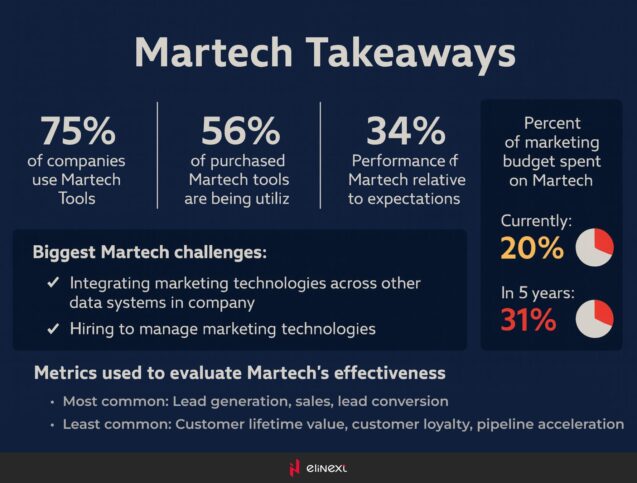Latest MarTech trends 2025 are revolutionizing the way companies engage with customers. AI and machine learning play a key role in marketing automation, enabling hyper-personalization and real-time analytics. Voice search optimization and audio marketing are also gaining popularity as smart speaker usage grows. Moreover, the shift to a cookie-less future puts an emphasis on first-party data and contextual targeting for privacy-focused marketing. These technologies are driving significant growth in MarTech, driving spending and new startups.

Trends in MarTech: what is the growing concern for marketers today?
Martech industry trends highlight issues such as data privacy, integration complexity, and declining brand loyalty. For example, in 2025, 74% of consumers will switch brands, often due to price or poor customer service. Marketers are concerned about managing fragmented data and complying with privacy laws. As a result, there is growing investment in unified platforms and analytics to address these issues and retain customers.
Latest Martech Trends: why Brand Loyalty Is Declining?
Brand loyalty is declining as mobile app development services and Martech trends make it easier for consumers to compare brands, access reviews, and switch with a single tap. For example, shoppers use apps to find better deals or brands that align with their values, which reduces long-term loyalty.
How can MarTech industry trends impact customer retention?
Brands use MarTech for personalized engagement, predictive analytics, and loyalty programs. AI software development services empower brands to predict churn, personalize offers, and automate support. For example, a retailer using AI-powered recommendations and real-time push notifications saw a 20% reduction in customer churn and a 40% increase in net revenue. MarTech helps track customer journeys, resolve issues, and deliver timely offers, directly increasing retention rates.
VR, AR and AI trends in MarTech
The latest MarTech trends show that VR, AR, and AI are transforming marketing in 2025. For example, brands are using AR for virtual try-ons, VR for immersive product demos, and AI for hyper-personalized campaigns, creating engaging, interactive experiences that increase customer engagement and conversion rates.
-
Virtual reality
Trends in martech show that virtual reality creates immersive brand experiences. For example, automotive brands use VR showrooms for virtual test drives, increasing engagement and sales. VR events and product launches enable global participation, and VR training improves employee skills. As VR gains popularity, marketers are using it for storytelling, product training, and interactive campaigns.
-
Augmented reality
Latest martech trends 2025 show that AI plays a central role in marketing. AI-powered software personalizes content, predicts trends, and automates campaigns. For example, Netflix uses AI to recommend TV shows, increasing audience retention. AI-powered chatbots provide instant support, and predictive analytics optimize ad spend. Marketers using AI report sales growth of over 10% and campaign ROI of 5-8x.
-
Artificial Intelligence
AI-powered software personalizes content, predicts trends, and automates campaigns. For example, Netflix uses AI to recommend TV shows, increasing audience retention. AI-powered chatbots provide instant support, and predictive analytics optimize ad spend. Marketers using AI report sales growth of over 10% and campaign ROI of 5-8x.

Bottomline
IoT software development company solutions show that the future of MarTech is driven by AI, augmented and virtual reality (AR/VR), and cloud integration. Brands using these tools deliver hyper-personalized, immersive experiences, increasing customer retention and ROI. For example, augmented reality (AR) try-ons and AI-powered recommendations drive sales and loyalty. With increasing demands for data privacy and integration, unified MarTech platforms and IoT connectivity will be key for marketers to stay ahead in 2025.
FAQ
What is MarTech?
Martech industry trends define MarTech as the combination of marketing and technology—tools like AI, analytics, and automation that help brands attract, engage, and retain customers. For example, using a CRM platform to personalize email campaigns is MarTech in action
Why is MarTech important for modern marketing strategies?
Latest martech trends 2025 show that MarTech plays a key role in personalized, data-driven marketing. For example, AI-powered tools analyze customer data to deliver targeted ads, increasing ROI and engagement. MarTech enables brands to quickly adapt and stay competitive.
How does AI influence marketing decisions?
Trends in MarTech show that AI analyzes customer data, predicts trends, and personalizes content. For example, AI-powered product recommendations on e-commerce sites increase conversions. Marketers use AI analytics to optimize campaigns and improve ROI.
What is a Customer Data Platform (CDP) and why is it important?
Martech industry trends show that CDPs unify customer data across all channels to enable personalized marketing. For example, a retailer uses a CDP to track customer behavior online and in stores, delivering targeted offers and increasing retention with a single view of customer data.
What role does marketing automation play in modern campaigns?
Latest MarTech trends highlight the importance of automation to improve efficiency – automated emails, social media posts, and ad targeting. For example, a brand uses automation to send personalized offers after a customer browses online, increasing engagement and freeing up marketing resources.
What impact does AR/VR have on marketing strategies?
Recent trends in marketing technology show that augmented and virtual reality are creating immersive experiences – virtual try-ons, 3D product demos, and interactive advertising. For example, IKEA’s augmented reality app allows users to visualize furniture at home, increasing trust and conversion.









